World War II
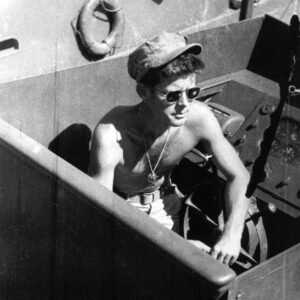
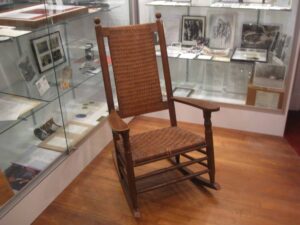 John F Kennedy, who at the time was still our future president, had to “fight” his way into war. His father believed it would make his son more “marketable” for a political run that would eventually land him in the White House. Joseph Kennedy wanted one of his sons to eventually be president, and I’m not sure he was particular about which one it was. He just knew that to have a chance, the “candidate” would have to have a military background. The reasons for his entrance into World War II really don’t matter now, because while he was in the service, he did his country proud, and even saved the lives of his PT-109 crew after a Japanese destroyer rammed them on August 2, 1943.
John F Kennedy, who at the time was still our future president, had to “fight” his way into war. His father believed it would make his son more “marketable” for a political run that would eventually land him in the White House. Joseph Kennedy wanted one of his sons to eventually be president, and I’m not sure he was particular about which one it was. He just knew that to have a chance, the “candidate” would have to have a military background. The reasons for his entrance into World War II really don’t matter now, because while he was in the service, he did his country proud, and even saved the lives of his PT-109 crew after a Japanese destroyer rammed them on August 2, 1943.
Future President Kennedy could have avoided the war completely, because he had back issues which were likely caused from a football injury. In addition, the fact that he was from a wealthy family could have been a big help in any effort he might have used to stay out of the war. He didn’t use the family’s money or influence to stay out, however. Before entering World War II, Kennedy graduated with honors from Harvard, and then still chose to serve. After being drafted to by the Navy, the physical toll on his back increased, including the physically demanding couple of days when the ship he commanded sank and he literally helped his crew survive.
Later, while he was serving as a young senator, Kennedy’s doctor prescribed a rocking chair to be used during his service in the senate. No matter where the pain initially started or what exacerbated the issue, by the time 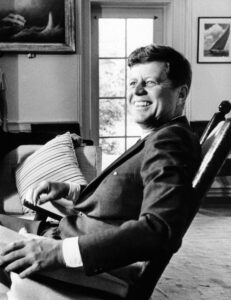
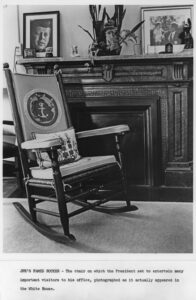 John F Kennedy was in the office of president, he was in constant pain. When he began using the rocking chair in 1955, Kennedy finally found a way for his muscles to relax by constantly being forced to expand and contract while sitting. The rocking chair he chose was made by P and P Chair Company, and Kennedy grew to love it. He finally found some relief, and he actually insisted that the chair be brought aboard Air Force One when he traveled. Later he just purchased many different chairs for his various residences. So impressed was Kennedy with this chair, that he also gifted dozens of the same chair to friends and colleagues. You might say that the rocking chairs from P and P Chair Company were unofficially known as the presidential rocking chairs.
John F Kennedy was in the office of president, he was in constant pain. When he began using the rocking chair in 1955, Kennedy finally found a way for his muscles to relax by constantly being forced to expand and contract while sitting. The rocking chair he chose was made by P and P Chair Company, and Kennedy grew to love it. He finally found some relief, and he actually insisted that the chair be brought aboard Air Force One when he traveled. Later he just purchased many different chairs for his various residences. So impressed was Kennedy with this chair, that he also gifted dozens of the same chair to friends and colleagues. You might say that the rocking chairs from P and P Chair Company were unofficially known as the presidential rocking chairs.
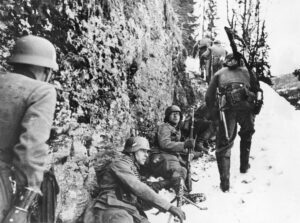 During the largely unsuccessful Norwegian Campaign of World War II, the Allies were in a fight to stop the Germans from fully occupying Norway, but it didn’t work in the end. The Norwegian campaign was carried out from April 8, 1940 to June 10, 1940, and involved the attempt by Allied forces to defend northern Norway coupled with the resistance of the Norwegian military to the country’s invasion by Nazi Germany.
During the largely unsuccessful Norwegian Campaign of World War II, the Allies were in a fight to stop the Germans from fully occupying Norway, but it didn’t work in the end. The Norwegian campaign was carried out from April 8, 1940 to June 10, 1940, and involved the attempt by Allied forces to defend northern Norway coupled with the resistance of the Norwegian military to the country’s invasion by Nazi Germany.
The Norwegian Campaign was planned as Operation Wilfred and Plan R 4, prior to the actual German attack, which the Allies knew was imminent, but had not yet happened. On April 4th, the battlecruiser HMS Renown set out from Scapa Flow for the Vestfjorden with twelve destroyers. The Royal Navy and the 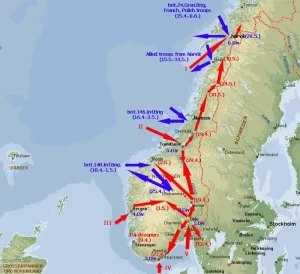 Kriegsmarine met at the First Battle of Narvik on April 9 – 10. The British forces conducted the Åndalsnes landings on April 13, thereby putting everything in place for the actual operation. Germany’s strategic reason for wanting Norway was to seize the port of Narvik and guarantee the delivery of iron ore needed for German steel production. In any war, steel is necessary for much of the weaponry.
Kriegsmarine met at the First Battle of Narvik on April 9 – 10. The British forces conducted the Åndalsnes landings on April 13, thereby putting everything in place for the actual operation. Germany’s strategic reason for wanting Norway was to seize the port of Narvik and guarantee the delivery of iron ore needed for German steel production. In any war, steel is necessary for much of the weaponry.
During one part of that campaign, in an air fight over Norway, a British fighter took down a German plane over a densely wooded area. Unfortunately, the British aircraft crashed as well. As it turns out, both crews survived the crashes, and while trying to get to a safe place, they encountered each other in the wilderness. In most situations, this could have been bad for one or both of the crews, but even though they were struggling against a language barrier, the rival airmen agreed not to turn on each other and instead, to team up in order to find  safety. They stayed in an abandoned hotel and shared breakfast. It wasn’t peace exactly, but they formed an uneasy truce, while they waited to see which side would show up to help first.
safety. They stayed in an abandoned hotel and shared breakfast. It wasn’t peace exactly, but they formed an uneasy truce, while they waited to see which side would show up to help first.
Instead of the British or the Germans, it was a Norwegian ski patrol that showed up to rescue the British soldiers, and of course, to take the Germans as POWs. While that one battle seemed to indicate that the British were headed for a victory over the Germans, that was not to be the case. The Germans did finally take over Norway in its entirety. Of course, as we all know, one battle is not a very good indication of who will win the war, and in the end, it was Germany that took a great fall, losing the entirety of World War II.
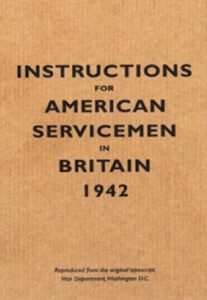
 In every branch of service, and every war, the US servicemen are given a handbook. The book is filled with useful information, meant to make the transition from civilian to soldier a successful one, even if it is not an easy one. No young civilian preparing to go to war really has a good idea of what they are getting into. I suppose more of them do these days, than their World War and prior wars era counterparts. Nevertheless, each of them is proceeding head on into a massive reality check. The handbook can be a sobering little book, especially when the new soldier reads the chapter that recommends the writing of a will. The need for a Last Will and Testament will become crystal clear when the soldier sees his (or her) first battle. The sight of dead bodies takes away any misconception the soldier might have of their own mortality, and the possibility that they may have been given a one-way ticket to this battle.
In every branch of service, and every war, the US servicemen are given a handbook. The book is filled with useful information, meant to make the transition from civilian to soldier a successful one, even if it is not an easy one. No young civilian preparing to go to war really has a good idea of what they are getting into. I suppose more of them do these days, than their World War and prior wars era counterparts. Nevertheless, each of them is proceeding head on into a massive reality check. The handbook can be a sobering little book, especially when the new soldier reads the chapter that recommends the writing of a will. The need for a Last Will and Testament will become crystal clear when the soldier sees his (or her) first battle. The sight of dead bodies takes away any misconception the soldier might have of their own mortality, and the possibility that they may have been given a one-way ticket to this battle.
While many of the things contained in the handbook are sobering and even quite scary for the soldiers, there are some things contained therein that have a much more practical usage, and a few that looking back, anyway, are just a little bit funny. One such tidbit contained in the US servicemen’s World War II handbook was the simple statement that, “The British don’t know how to make a good cup of coffee. You don’t know how to make a good cup of tea—it’s an even swap.” I suppose that statement is true, at least as it pertains to the fact that British “bad coffee” is an even swap with US “bad tea.” I don’t think they US government was trying to “bad-mouth” the Brits, but rather that they were simply stating a fact. If the men were in a British camp, they simply shouldn’t ask for a cup of coffee, because they would be sorely disappointed in what they were served.
Like the warning labels of items these days, like not to shower with a running blow dryer, or to shut off the engine before trying to remove the fan belt on your car, the point was to make the reader aware of the ramifications of making such bad choices. Still, some “warnings” make more sense than others…or do they? While the electricity problem of the wet running blow dryer and the finger removal outcome of putting one’s  hand out to touch a fast-moving fan belt, seem like rather stupid wisdom (is there is such a phrase), the idea that a person would automatically make a bad cup of coffee, simply because they are British, seems equally ridiculous. Nevertheless, the US servicemen were warned to expect “bad coffee” from the British, so that they were prepared to either drink tea with the Brits, or swallow down the offending coffee so as not to offend the Brits. I’m sure that much of the rest of the handbook contained valuable information, but it is possible that the most valuable information contained in the World War II US servicemen’s handbook, was intended to avoid the notion that the Brit might have poisoned them with the British coffee.
hand out to touch a fast-moving fan belt, seem like rather stupid wisdom (is there is such a phrase), the idea that a person would automatically make a bad cup of coffee, simply because they are British, seems equally ridiculous. Nevertheless, the US servicemen were warned to expect “bad coffee” from the British, so that they were prepared to either drink tea with the Brits, or swallow down the offending coffee so as not to offend the Brits. I’m sure that much of the rest of the handbook contained valuable information, but it is possible that the most valuable information contained in the World War II US servicemen’s handbook, was intended to avoid the notion that the Brit might have poisoned them with the British coffee.
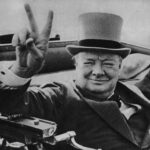 Many people today think of the “V” sign as meaning Peace, but in reality, the “V” sign used today was actually hijacked. The original “V” sign meant Victory, and it was originally presented as such by Winston Spencer-Churchill at a time when Britain is at one of its lowest points in World War II. Churchill is well known as one of the greatest motivators and speech makers of his time. On July 19, 1941, he launched the “V for Victory” campaign across Europe by telling those in Europe under Nazi control to use the letter “V” (for Victory) at every chance they got in speaking and writing. Churchill urged them to write a capital letter “V” to signify “V” for Victory. This was designed to let the Germans know they still had spirit and believed they would overcome Nazi Rule. The morale of the people was so important and this low point in history. When people give up hope, wars are lost…even before the battles are lost.
Many people today think of the “V” sign as meaning Peace, but in reality, the “V” sign used today was actually hijacked. The original “V” sign meant Victory, and it was originally presented as such by Winston Spencer-Churchill at a time when Britain is at one of its lowest points in World War II. Churchill is well known as one of the greatest motivators and speech makers of his time. On July 19, 1941, he launched the “V for Victory” campaign across Europe by telling those in Europe under Nazi control to use the letter “V” (for Victory) at every chance they got in speaking and writing. Churchill urged them to write a capital letter “V” to signify “V” for Victory. This was designed to let the Germans know they still had spirit and believed they would overcome Nazi Rule. The morale of the people was so important and this low point in history. When people give up hope, wars are lost…even before the battles are lost.
In this campaign, Churchill first gave a speech over the radio to tell the people of his plan. Immediately following his speech, the letter “V” began to appear everywhere. It was painted on walls, tapped out in Morse code on shop counters with knuckles or beer glasses or pencil stubs. It quickly became a rallying call across Europe that there was still hope. Many people weren’t aware, but this is also why Churchill’s most famous pictures from World War II always featured him giving the “V” for Victory Sign. He was continuously telling the people not to give up. That all was not lost, and Victory would still be theirs. We all know the “V” sign. Of course, it was made using the index and middle fingers, raised and parted to make a “V” shape while the other fingers are clenched.
These days, it can mean a number of things, and not all are good. When it is displayed with the palm inward 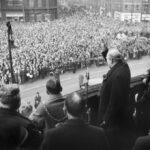 toward the signer, it can be an offensive gesture in some Commonwealth nations (similar to showing the middle finger). That usage dates back to at least 1900. When it is given with the palm outward, it is to be read as a victory sign (“V for Victory”). This usage was first introduced in January 1941 as part of a campaign by the Allies of World War II and made more widely known by Churchill the following July. As most of us know, during the Vietnam War, in the 1960s, the “V sign” with palm outward was widely adopted by the counterculture as a symbol of peace. These days, that is the most commonly used meaning and is commonly called the “peace sign.” Of course, most of us also know that it is used for fun in photographs, especially in East Asia and the United States, where the gesture is also associated with cuteness…the “rabbit ears.” That one is one I have never really figured out. Not what it is, but why people think it’s so funny. Oh well…to each his own.
toward the signer, it can be an offensive gesture in some Commonwealth nations (similar to showing the middle finger). That usage dates back to at least 1900. When it is given with the palm outward, it is to be read as a victory sign (“V for Victory”). This usage was first introduced in January 1941 as part of a campaign by the Allies of World War II and made more widely known by Churchill the following July. As most of us know, during the Vietnam War, in the 1960s, the “V sign” with palm outward was widely adopted by the counterculture as a symbol of peace. These days, that is the most commonly used meaning and is commonly called the “peace sign.” Of course, most of us also know that it is used for fun in photographs, especially in East Asia and the United States, where the gesture is also associated with cuteness…the “rabbit ears.” That one is one I have never really figured out. Not what it is, but why people think it’s so funny. Oh well…to each his own.
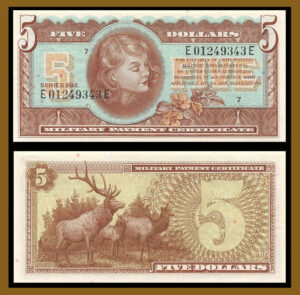 During World War II, and through the Vietnam War, the United States government was facing a situation with the US dollar that was different from prior years. It’s not something we really think about much, but it had to do with the fact that the countries the US Military was in were unsure of how their money was going to play out if they were one of the countries that fell. The dollar was stable, so they were happy to take payment in the US dollar over their own currency. In fact, the local civilians often accepted payment in dollars for less than the accepted conversion rates, meaning that they lost money in the deal. Dollars became more favorable to hold, which further inflated the local currencies, defeating plans to stabilize local economies. On top of that, troops were being paid in dollars, which they could
During World War II, and through the Vietnam War, the United States government was facing a situation with the US dollar that was different from prior years. It’s not something we really think about much, but it had to do with the fact that the countries the US Military was in were unsure of how their money was going to play out if they were one of the countries that fell. The dollar was stable, so they were happy to take payment in the US dollar over their own currency. In fact, the local civilians often accepted payment in dollars for less than the accepted conversion rates, meaning that they lost money in the deal. Dollars became more favorable to hold, which further inflated the local currencies, defeating plans to stabilize local economies. On top of that, troops were being paid in dollars, which they could  convert in unlimited amounts to the local currency with merchants at the floating (black market) conversion rate, which was much more than the government fixed conversion rate. It was rather a great money-making proposition, but really wasn’t ethical. This conversion rate imbalance allowed the servicemen to profit from the more favorable exchange rate.
convert in unlimited amounts to the local currency with merchants at the floating (black market) conversion rate, which was much more than the government fixed conversion rate. It was rather a great money-making proposition, but really wasn’t ethical. This conversion rate imbalance allowed the servicemen to profit from the more favorable exchange rate.
While anyone could understand how people would want to make money if they can, it was really going to be damaging to the local economy in the end. The MPCs were designed to stop the unfair conversion rate of currency. The scrip (MOCs) was changed out periodically, to avoid hoarding. Once they came out with a new version of scrip, the prior version became worthless. Another way they were supposed to eliminate the problem was that MPCs were only allowed to be used by military personnel in military facilities and approved locations. As a safeguard, if the MPCs  were converted to local currency, they were not allowed to be reconverted to MPCs, so the plan was useless. US MPCs were in use from 1946-1973 and were used in all overseas military locations.
were converted to local currency, they were not allowed to be reconverted to MPCs, so the plan was useless. US MPCs were in use from 1946-1973 and were used in all overseas military locations.
I was actually watching an episode of MASH this morning about this very thing. The men were buying up the old scrip from people who couldn’t get to the exchange. Of course, they bought it for less than its value, planning to cash in when they turned it in for its face value. The solution for that problem was that the military personnel were restricted to the base on C-Days…currency exchange days. I don’t know how much of the fraudulent exchanges were stopped in this way, but it might have stopped some.

 It’s not often that a young man “pulls strings” in order to go to war. Most men would rather not go to war, and some will even try to “pull strings” to get out of going. John F Kennedy, who had some health problems, and an old back injury from his college football days, was turned down for the Navy, but his dad managed to pull some strings for his son, who really wanted to go into the navy. Young was desperate, and like most parents, his father wanted to help fulfill that dream. So in 1941, Kennedy’s politically connected father, Joseph Kennedy used his influence to get his sin, John “Jack” into the service. Of course, Joseph might have been thinking ahead to future political maneuvers when he pushed for a military career for his son. Once in the Navy, Kennedy volunteered for PT (motorized torpedo) boat duty in the Pacific in 1942.
It’s not often that a young man “pulls strings” in order to go to war. Most men would rather not go to war, and some will even try to “pull strings” to get out of going. John F Kennedy, who had some health problems, and an old back injury from his college football days, was turned down for the Navy, but his dad managed to pull some strings for his son, who really wanted to go into the navy. Young was desperate, and like most parents, his father wanted to help fulfill that dream. So in 1941, Kennedy’s politically connected father, Joseph Kennedy used his influence to get his sin, John “Jack” into the service. Of course, Joseph might have been thinking ahead to future political maneuvers when he pushed for a military career for his son. Once in the Navy, Kennedy volunteered for PT (motorized torpedo) boat duty in the Pacific in 1942.
“Jack” Kennedy quickly worked to move himself up in rank, and soon he was Lieutenant John F. Kennedy. July 1943 found Lieutenant Kennedy and the crew of PT 109 in combat near the Solomon Islands. People often think that being in the Navy or the Air Force is somehow safer than the Army or Marines, but the reality is that any position in a war 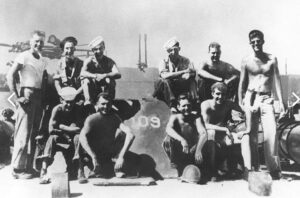
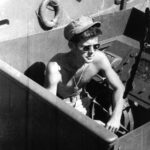 can prove to be dangerous. On August 2, 1943, the middle of the night, Kennedy’s boat was rammed by a Japanese destroyer and caught fire. In the ensuing explosion, several of Kennedy’s shipmates were blown overboard into a sea of burning oil. With no regard for his own life, Kennedy dove in to rescue three of the crew and in the process swallowed some of the toxic mixture. Kennedy always blamed his chronic stomach problems on that incident. The ordeal was not quickly over, and for 12 hours, Kennedy and his men clung to the wrecked hull. Finally, he ordered them to abandon ship. Kennedy and the other good swimmers placed the injured on a makeshift raft. They took turns pushing and towing the raft four miles to safety on a nearby island.
can prove to be dangerous. On August 2, 1943, the middle of the night, Kennedy’s boat was rammed by a Japanese destroyer and caught fire. In the ensuing explosion, several of Kennedy’s shipmates were blown overboard into a sea of burning oil. With no regard for his own life, Kennedy dove in to rescue three of the crew and in the process swallowed some of the toxic mixture. Kennedy always blamed his chronic stomach problems on that incident. The ordeal was not quickly over, and for 12 hours, Kennedy and his men clung to the wrecked hull. Finally, he ordered them to abandon ship. Kennedy and the other good swimmers placed the injured on a makeshift raft. They took turns pushing and towing the raft four miles to safety on a nearby island.
Their ordeal still wasn’t over. For six days, Kennedy and his crew waited on the island for rescue. There was little to eat on the island, but the men survived by drinking coconut milk and rainwater until native islanders discovered the sailors and offered food and shelter. While they waited, Kennedy tried every night to signal other US Navy ships in the area. In addition, Kennedy scrawled a message on a coconut husk and gestured to the islanders to take it to a nearby PT base at Rendova. Finally, on August 8, a Navy patrol boat picked up the survivors of PT-109.
The men were taken to the hospital to recuperate, and on June 12, 1944, while Kennedy was in the hospital recuperating from back surgery, he received the Navy and Marine Corps medal for “courage, endurance, and 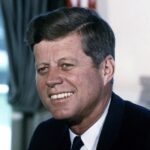
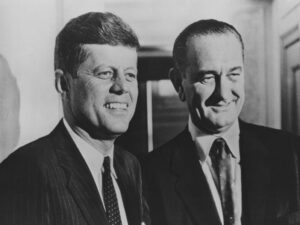 excellent leadership [that] contributed to the saving of several lives and was in keeping with the highest traditions of the United States Naval Service.”
excellent leadership [that] contributed to the saving of several lives and was in keeping with the highest traditions of the United States Naval Service.”
Of course, the rest is history. John F Kennedy went on to become the 35th President of the United States, and on November 22, 1963, Kennedy was assassinated in Dallas. His vice president, Lyndon B Johnson, assumed the presidency upon Kennedy’s death.
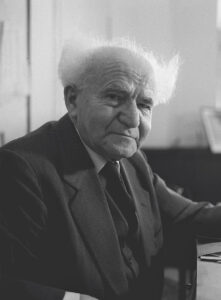
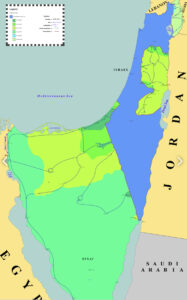 Since the earliest beginnings of Israel, the Arab community has been protesting its existence and trying to remove it from the face of the Earth. I don’t particularly understand what their problem uis. Given the tiny size of Israel compared to the vastness of the Arab nations, why is it so hard to allow them to live in peace? It is, of course a Holy War situation that is unlikely to go away for as long as time continues.
Since the earliest beginnings of Israel, the Arab community has been protesting its existence and trying to remove it from the face of the Earth. I don’t particularly understand what their problem uis. Given the tiny size of Israel compared to the vastness of the Arab nations, why is it so hard to allow them to live in peace? It is, of course a Holy War situation that is unlikely to go away for as long as time continues.
Israel had been a nation way, way back, but when they were taken into captivity, they were scattered to many nations. Once they were freed, they traveled to Israel (I think most people know the Exodus story). Of course, their existence was fought over again and again, finally leading up to the Holocaust. When World War II ended, many of the Jewish people again moved to and populated the Israeli land, but it wasn’t until May 14, 1948, that David Ben-Gurion, the head of the Jewish Agency, proclaimed the establishment of the State of Israel. United States President Harry S Truman recognized the new nation on the same day. Since that time, there have been multiple wars and continuing conflicts that have threatened the existence of the Israeli state.
One such war was the Six-Day War, also called June War or Third Arab-Israeli War or Naksah. It was a short-lived war that took place from June 5, 1967 to June 10, 1967. It was the third of the Arab-Israeli wars. The first took place almost immediately after they were declared a state. The Israeli people have learned to fight for survival all their lives, vowing never to allow another Holocaust to be carried out. Israel’s decisive victory in the Six-Day War included the capture of the Sinai Peninsula, Gaza Strip, West Bank, Old City of Jerusalem, and Golan Heights. Of course, things didn’t end there. The fact that these territories belonged to Israel has been a major point of contention in the Arab-Israeli conflict sin that time.
The Six-Day War had precursors, as most wars do. Prior to the start of the war, the Palestinian guerrilla groups based in Syria, Lebanon, and Jordan randomly began attacking Israel, basically lobbing missiles at them, leading to costly 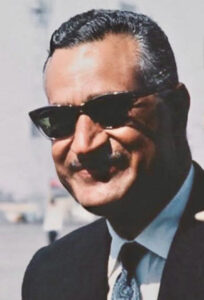
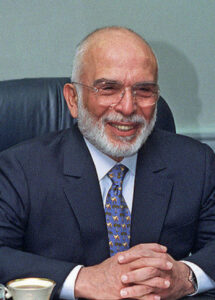 Israeli reprisals. Then, in November 1966 an Israeli strike on the village of Al-Sam in the Jordanian West Bank left 18 dead and 54 wounded, and during an air battle with Syria in April 1967, the Israeli Air Force shot down six Syrian MiG fighter jets. Soviet intelligence reports in May claimed that Israel was planning a campaign against Syria, and although these claims were inaccurate, the accusations further heightened tensions between Israel and its Arab neighbors.
Israeli reprisals. Then, in November 1966 an Israeli strike on the village of Al-Sam in the Jordanian West Bank left 18 dead and 54 wounded, and during an air battle with Syria in April 1967, the Israeli Air Force shot down six Syrian MiG fighter jets. Soviet intelligence reports in May claimed that Israel was planning a campaign against Syria, and although these claims were inaccurate, the accusations further heightened tensions between Israel and its Arab neighbors.
During this time, Egyptian President Gamal Abdel Nasser had come under sharp criticism for his refusing to become involved with Syria and Jordan against Israel. He was accused of hiding behind the United Nations Emergency Force (UNEF) stationed at Egypt’s border with Israel in the Sinai. Under pressure, he moved to unambiguously demonstrate support for Syria on May 14, 1967. Nasser mobilized Egyptian forces in the Sinai on May 18, 1967 and formally requested the removal of the UNEF stationed there. On May 22, 1967, he closed the Gulf of Aqaba to Israeli shipping, thus instituting an effective blockade of the port city of Elat in southern Israel. On May 30, 1967, King Hussein of Jordan arrived in Cairo to sign a mutual defense pact with Egypt, placing Jordanian forces under Egyptian command. Iraq joined the alliance shortly thereafter.
As Israel became aware of the mobilization of its Arab neighbors, early on the morning of June 5, 1967, Israel took preemptive action and staged an air assault that destroyed more than 90 percent Egypt’s air force on the tarmac. A similar air assault incapacitated the Syrian air force. Without cover from the air, the Egyptian army was left vulnerable to attack. The domination in this war became apparent right away, and within three days the Israelis had achieved an overwhelming victory on the ground, capturing the Gaza Strip and all of the Sinai Peninsula up to the east bank of the Suez Canal.
Israel warned Jordan’s King Hussein to stay out of the conflict, but they disregarded the warning, and eastern front was also opened on June 5, 1967, when Jordanian forces began shelling West Jerusalem only to face a crushing 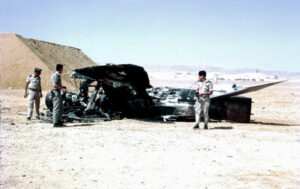
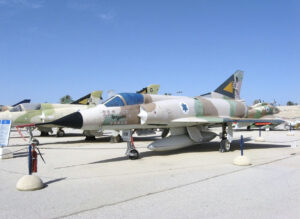 Israeli counterattack. On June 7, 1967, Israeli forces drove Jordanian forces out of East Jerusalem and most of the West Bank. By June 10, 1967, the war was over and Israel was the obvious winner. It seems to me that the Arab nations should heed the warnings of history, and leave Israel alone, but I suppose that is unlikely. Nevertheless, Israeli land belongs to the Jewish people by the promise of God and they would do well to let it go.
Israeli counterattack. On June 7, 1967, Israeli forces drove Jordanian forces out of East Jerusalem and most of the West Bank. By June 10, 1967, the war was over and Israel was the obvious winner. It seems to me that the Arab nations should heed the warnings of history, and leave Israel alone, but I suppose that is unlikely. Nevertheless, Israeli land belongs to the Jewish people by the promise of God and they would do well to let it go.
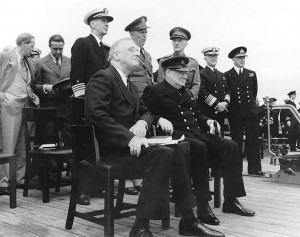

 In a military operation, especially as part of a war, absolute secrecy is vital. Those involved with the planning have to know that they can trust everyone who is around them. One of the most important operations of World War II was the D-Day attack…Operation Overlord. Success was vital, and failure was simply not an option, no matter how many men were lost. The attack on Pearl Harbor had finally drawn the United States into World War II, and now we were in it to win it.
In a military operation, especially as part of a war, absolute secrecy is vital. Those involved with the planning have to know that they can trust everyone who is around them. One of the most important operations of World War II was the D-Day attack…Operation Overlord. Success was vital, and failure was simply not an option, no matter how many men were lost. The attack on Pearl Harbor had finally drawn the United States into World War II, and now we were in it to win it.
The success of any mission is found in the planning, so in August 1943, Franklin D Roosevelt and Winston Churchill met in Quebec for the first of two meetings code-named “Quadrant.” Technically, the meeting was the first of two “Quebec Conferences.” The meetings couldn’t even officially talk about the name of the actual operation, “Operation Overlord, which was later known as D-Day to the world. The Americans and the Brits had differences of opinion as to just how the operation was to be handled, but in order to make this operation work, they would have to be in complete agreement, and the mission would have to be kept completely covert!! No one could know the details.
Everyone, from the top men down to the paper supplier was screened to make sure of their loyalties. No stone was left unturned. If any information was leaked, thousands of men could die, and the fate of the world could have been severely compromised. Nevertheless, something was “missed” somehow. A young Canadian named Émile Couture was in charge of stationery supplies that fateful day, and in reality, he had no intention of being a traitor or playing any other nefarious part in the leak of information into the operation. Nevertheless, he managed to walk out of those meetings with the tactical plans for the invasions. It wasn’t even accidental…exactly.
Roosevelt and Churchill were excellent strategists, and their very detailed plans were perfectly laid out. The operation was going to be an amazing success. Now, all they had to do was to keep everything secret until the actual day, as yet unnamed, of the operation. The plans included detailed listings of Allied military assets to be used in the landings…the number of planes, combat cars, ships, and ground soldiers. They only had to keep it very quiet, because the leak of this information could have turned the tide of the war in favor of the Axis powers, and had that happened, our world would be vastly different even from the strange world we are experiencing today. Sergeant Major Émile Couture had been tasked with cleaning up after the meetings and instructed to make sure nothing was left behind.
Couture was doing his job in a meticulous fashion, but while cleaning an office on the third floor of the hotel, he discovered a leather portfolio that was inscribed “Churchill-Roosevelt, Quebec Conference, 1943. Maybe he thought it was just an empty portfolio, and so thought he could actually have an amazing souvenir of such a monumental meeting. Just think of the stories he could tell his children and grandchildren about the time he got to help out with such an important meeting between two of the most important men if his time. History doesn’t really tell us what he was thinking, but he decided to keep the portfolio as a souvenir without realizing what was actually in the portfolio.  Couture walked out of the Château Frontenac without anyone being any the wiser and drove to the cottage where he was living with his cousins in Lac-Beauport just a few miles outside of Quebec City. Then he took time to examine his “treasure” only to find that he could actually be tried for treason. Couture was more than frightened. He was terrified, and he hid the files under his mattress overnight.
Couture walked out of the Château Frontenac without anyone being any the wiser and drove to the cottage where he was living with his cousins in Lac-Beauport just a few miles outside of Quebec City. Then he took time to examine his “treasure” only to find that he could actually be tried for treason. Couture was more than frightened. He was terrified, and he hid the files under his mattress overnight.
In the morning, knowing that he would have to face the music, he took the portfolio and its files to his superior, Brigadier Edmond Blais. Blais told Couture to go home and wait. He would be dealt with in the morning. Couture could have been put in prison for the remainder of the war in order to make certain that he did not leak the information he had seen. He was, after all, a low-ranking soldier, and shouldn’t have access to such top-secret information. Instead, he was sent home after being questioned by Scotland Yard and the FBI.
Whether Couture was terrified to say anything, or just an honorable soldier, he never leaked the information he had seen. Blais must have liked Couture, because he sent a letter on August 28, 1943, in which he recommended the Sergeant Major Émile Couture be awarded “the greatest accomplishment that can be given an NCO (non-commissioned officer).
On June 6, 1944, the Allies staged the largest amphibious military landing in history. Always remembered as D-Day, Operation Overlord saw 150,000 troops hit the beaches of Normandy, push back the German army and set the course for the eventual victory of the Allied forces. The secret of D-Day was kept, and the operation went off without a hitch.
Couture was rewarded for his discretion during a ceremony in September 1944, when he was commended for his actions by being granted a British Empire Medal. During the ceremony, there was no mention of what Couture had actually done to merit the award other than “services rendered.” I wonder if anyone thought that odd. Nevertheless, they really couldn’t tell, because it would have been embarrassing to the military for the public to see how easily someone walked out of the hotel with top secret documents.
Couture’s daughter, Anne Couture, insists that her father never told anyone. But someone did leak the story, and Couture became the center of the media’s attention. He gave several interviews over time, but he never told anyone whose office he had been cleaning when he found the documents or who he thought might have left them there. Though, Anne admits, he may have told her mother. If he did, Georgette Larochelle isn’t telling anyone, and in an effort to clear the record concerning her husband’s involvement in the whole incident. She has turned over all the memorabilia and documentation the family has kept over the years. It has all been donated to the Royal Museum and has been displayed in an exhibit since the 75th anniversary of the 2nd 
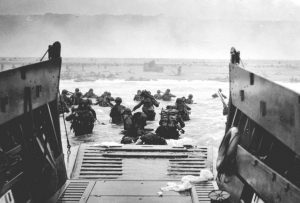 Quebec Conference.
Quebec Conference.
According to the museum’s director and curator, the documents are “convincing and some of the artifacts are considered invaluable” to the museum. He called the personal items which were specially made for the conference, “a great witness of this event of national significance.”
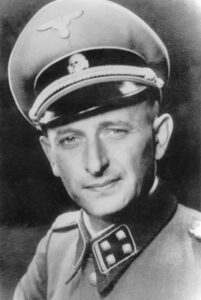 Following the end of World War II, many members of the Third Reich fled Germany, and relocated to Argentina this had all been planned as it became more and more clear that the Nazi Regime would not be successful. The ultimate plan was to lay low for a while, and then form a new Third Reich, or more likely the Fourth Reich. The main figures of the Third Reich were given new identities and smuggled out as soon as they could. It is unknown just exactly how many made it out, but files discovered in Argentina reveal the names of 12,000 Nazis who lived there in the 1930s, many of whom had Swiss bank accounts.
Following the end of World War II, many members of the Third Reich fled Germany, and relocated to Argentina this had all been planned as it became more and more clear that the Nazi Regime would not be successful. The ultimate plan was to lay low for a while, and then form a new Third Reich, or more likely the Fourth Reich. The main figures of the Third Reich were given new identities and smuggled out as soon as they could. It is unknown just exactly how many made it out, but files discovered in Argentina reveal the names of 12,000 Nazis who lived there in the 1930s, many of whom had Swiss bank accounts.
The Jewish people were understandably furious at not only the atrocities that their people had been subjected to, but the fact that with the escape, the fact is that many of the Nazi criminals would never answer for what they did, much less be punished for those atrocities. Nevertheless, the initial intent was to seek justice.
So, on December 13, 1949, Mossad was established. It later became the Institute for Intelligence and Special Operations. While Mossad has many uses today, it was primarily designed to go out and get the war criminals who were in hiding in Argentina and other parts of South America,  where there was no extradition. Mossad planned to go in without authorization, kidnap the Nazi war criminals, and take them to Israel to stand trial.
where there was no extradition. Mossad planned to go in without authorization, kidnap the Nazi war criminals, and take them to Israel to stand trial.
Some people may assume that Israel’s vaunted Mossad intelligence service devoted a great deal of energy to hunting for Nazis to seek revenge for the Holocaust. That was not the case. The desire to bring the murderers of Jews to justice was not deemed as important to Israel’s leaders in the early years of statehood as more pressing issues directly effecting the nation’s security. One of those issues, was preventing Nazis who went to Egypt from aiding in Nasser’s development of missile technology.
There were a few of the war criminals that the Mossad brought to Justice. One well known criminal was Adolf Eichmann, the man who engineered the Final Solution. His “contribution” to the atrocity that was the Holocaust was one of the most heinous. In 1960, Mossad tracked Eighmann to his home in Argentina, kidnapped him, and brought 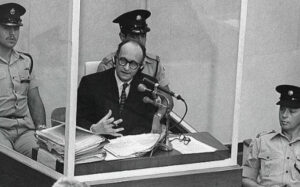 him to trial in Israel. He was convicted of war crimes and was actually the only person ever sentenced to death in Israel. The Argentinian government was furious because their no extradition policy was violated by Mossad. The immediately demanded that Israel return Eichmann, and then asked for reparations for Eichmann’s seizure by Mossad agents in Buenos Aires. Nevertheless, on August 2, 1969 the dispute was resolved by Israel keeping Eichmann, but acknowledging that Argentina’s fundamental rights had been infringed upon. No further repercussions were given.
him to trial in Israel. He was convicted of war crimes and was actually the only person ever sentenced to death in Israel. The Argentinian government was furious because their no extradition policy was violated by Mossad. The immediately demanded that Israel return Eichmann, and then asked for reparations for Eichmann’s seizure by Mossad agents in Buenos Aires. Nevertheless, on August 2, 1969 the dispute was resolved by Israel keeping Eichmann, but acknowledging that Argentina’s fundamental rights had been infringed upon. No further repercussions were given.
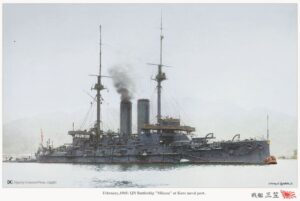 It is not usually my habit to talk about the spectacular ships built by our nation’s enemies, but IJN Mikasa might be a worthy exception. The Mikasa is a “pre-dreadnought” battleship built for the Imperial Japanese Navy (IJN) in the late 1890s and is the only ship of her class. I didn’t know what a “pre-dreadnought” ship was, so I looked into it. “Pre-dreadnoughts were battleships built before 1906, when HMS Dreadnought was launched. Dreadnoughts were more powerful battleships that followed the design of HMS Dreadnought and so made pre-dreadnoughts obsolete.” The ship displaced over 15,000 long tons, with a crew of over 800 men.
It is not usually my habit to talk about the spectacular ships built by our nation’s enemies, but IJN Mikasa might be a worthy exception. The Mikasa is a “pre-dreadnought” battleship built for the Imperial Japanese Navy (IJN) in the late 1890s and is the only ship of her class. I didn’t know what a “pre-dreadnought” ship was, so I looked into it. “Pre-dreadnoughts were battleships built before 1906, when HMS Dreadnought was launched. Dreadnoughts were more powerful battleships that followed the design of HMS Dreadnought and so made pre-dreadnoughts obsolete.” The ship displaced over 15,000 long tons, with a crew of over 800 men.
While she might not have been as powerful, IJN Mikasa was nevertheless a well-built ship, that was able to withstand more than most ships of her time. Named after Mount Mikasa in Nara, Japan, she served as the flagship of Vice Admiral Togo Heihachiro throughout the Russo-Japanese War of 1904–1905. That war included the Battle of Port Arthur, which occurred on the second day of the war, as well as the Battles of the Yellow Sea and Tsushima. Just a few days after the Russo-Japanese War ended, Mikasa’s magazine (a ship’s magazine is where the powder and shells are stored) suddenly exploded and sank the ship. The explosion killed 251 men. Shortly before the Mikasa’s fatal accident, the ship had been involved in the 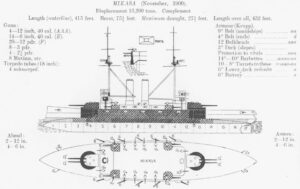 Battle of Tsushima (May 27, 1905), during which she had shrugged off over 40 shell strikes from heavy Russian naval guns! In that battle 113 of her crew were killed or injured. While such an event would usually mean the end of a ship, IJN Mikasa was salvaged, and while her repairs took over two years to complete, she went on to serve as a coast-defense ship during World War I, and she supported Japanese forces during the Siberian Intervention in the Russian Civil War. Ironically, in 1912 a despondent sailor among her crew tried to blow the ship up once again while the ship was anchored at Kobe. In the end the ship served until 1923, after being pulled up from the drink, repaired, and recommissioned.
Battle of Tsushima (May 27, 1905), during which she had shrugged off over 40 shell strikes from heavy Russian naval guns! In that battle 113 of her crew were killed or injured. While such an event would usually mean the end of a ship, IJN Mikasa was salvaged, and while her repairs took over two years to complete, she went on to serve as a coast-defense ship during World War I, and she supported Japanese forces during the Siberian Intervention in the Russian Civil War. Ironically, in 1912 a despondent sailor among her crew tried to blow the ship up once again while the ship was anchored at Kobe. In the end the ship served until 1923, after being pulled up from the drink, repaired, and recommissioned.
IJN Mikasa was decommissioned on September 23, 1923, following the Washington Naval Treaty of 1922. At that time, she was scheduled for destruction, but at the request of the Japanese government, each of the signatory countries to the treaty agreed that Mikasa could be preserved as a memorial ship. The agreement required that her hull be encased in concrete. On November 12, 1926, Mikasa was opened for display in Yokosuka in the presence of Crown Prince Hirohito and Togo. Unfortunately, the ship deteriorated under the  control of the occupation forces after the surrender of Japan in 1945. Finally, in 1955, American businessman John Rubin, who had formally lived in Barrow, England, wrote a letter to the Japan Times about the state of the ship. His letter served as the catalyst for a new restoration campaign. The Japanese public, who were widely onboard with the idea, supported the project, as did Fleet Admiral Chester W Nimitz. The ship was once again restored, and the museum version reopened in 1961. On August 5, 2009, IJN Mikasa was repainted by sailors from USS Nimitz, and she is now the only surviving example of a “pre-dreadnought” battleship in the world. IJN Mikasa is located in the town of its construction, Barrow-in-Furness, near Mikasa Street on Walney Island.
control of the occupation forces after the surrender of Japan in 1945. Finally, in 1955, American businessman John Rubin, who had formally lived in Barrow, England, wrote a letter to the Japan Times about the state of the ship. His letter served as the catalyst for a new restoration campaign. The Japanese public, who were widely onboard with the idea, supported the project, as did Fleet Admiral Chester W Nimitz. The ship was once again restored, and the museum version reopened in 1961. On August 5, 2009, IJN Mikasa was repainted by sailors from USS Nimitz, and she is now the only surviving example of a “pre-dreadnought” battleship in the world. IJN Mikasa is located in the town of its construction, Barrow-in-Furness, near Mikasa Street on Walney Island.

